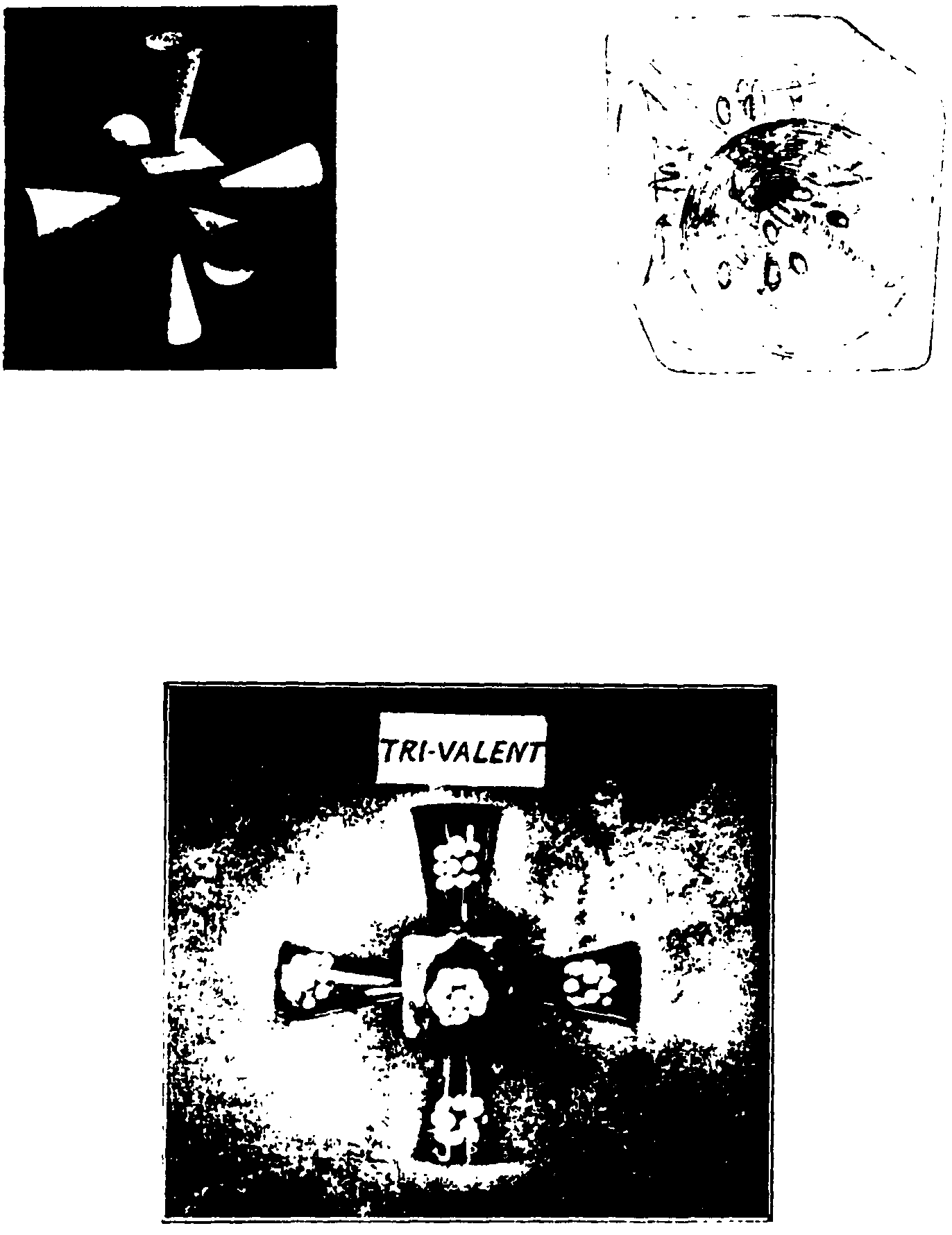
FIG. 76. TYPES OF THE CUBE GROUP
CHAPTER VII
THE CUBE GROUP A

CHAPTER VII
THE CUBE GROUP A
ALL the members of this group, with the exception of Nitrogen, have the external form of a cube. Fig. 76. They occur on the left hand swing of. the pendulum. Their characteristic valence is three, but higher valencies are developed. They all have six funnels opening on the six faces of a cube, and in two cases there are also spikes pointing to the eight corners of the cube. At first sight it would appear that Nitrogen should not be placed in this group but, as we shall see, the constituents of Nitrogen occur constantly in the
components making up the funnels of the elements in this group..
ATOMIC ANU ELEMENT CENTRE 6 FUNNELS
NO.
5
200 Boron (4 B5) 6 [4 (2H3)+Ad6]
7
261 Nitrogen (N110+N63+
2N24+2N20)
21
792 Scandium (4 B5+Be4) 3 [N110+4 (2H3)+Ad6]
3
[N63+2N24+B5]
23
918 Vanadium (4 B5+L7) 3 [N110+N20+4 (2H3)+Ad6]
3
[N63+2N24+N20+N6]
39
1,606 Yttrium (Ad24+Yt16) 6 [N63+N110+Yt44+(4Yt8+2Ad6)]
41
1,719 Niobium (2Ad24+N9) 6 [N63+N110+Yt44+Nb60]
57
2.482 Lanthanum (Ne120+7) 3 [N63+N110+Mo46+Ca70+Yt44+
Nb60
]
3
[N63+N11O+Ca45+Ca7O+Yt44+
Nb60]
59
2,527 Praeseodymium (Ce27+30 Ce32) 6 [Pr33+N63+N110+Yt44+N660]
=Ce667
71
3,171 Lutecium (Ce27+ 24Ba33) 6 [N63 + N110+ Lu53+ Ca70+ Lu36 +
=Lu819
Nb60 ]
73
3,279 Tantalum Lu819 6 [N63+N110+Ta63+Ca70+Yt44+
Nb60]
$9
4.140 Actinium Lu819 3 [N63+N110+Mo46+Ca160+Yt44+
N
660]
3
[Zr212+Sb128+Ac116]
+
8 Li63
91
4,227 Proto-Actinium Lu819 3 CN63 +N110+Mo46+Ca160+Yt44+
Nb60]
3
[ Zr212+Sb128+Ac116+Pa29]
+
8 Li63
19
146
OCCULT CHEMISTRY
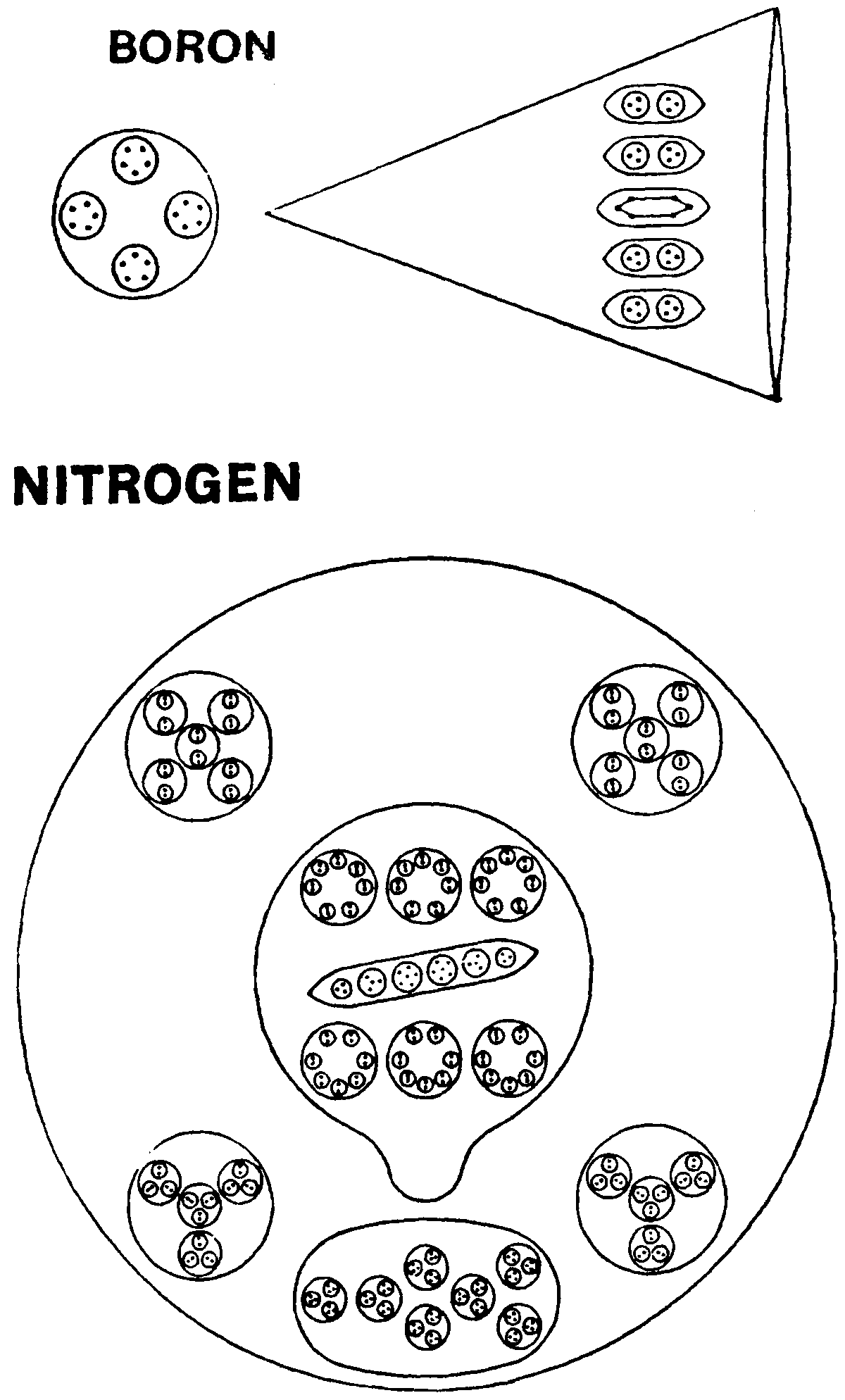
FIG.
77. BORON. NITROGEN
THE CUBE GROUP A 147
ATOMIC
NO. 5. BORON
In
Boron we have the simplest form of the cube. Fig. 77. It is as simple in
relation to the other members of its group as is Beryllium.
The
Central globe has four spheres of five Anu, 4B5.
The funnels contain five bodies also, four ovoids each of 2H3, and one Ad6. All six funnels are alike.
Boron
= 4B5+6 [4 (2H3)-f-Ad6]
Central
globe
---
20 Anu
6 funnels each of 30 Anu = 180 _
Total = 200 Anu
Number weight ~ = 11.11
ATOMIC
NO 7 NITROGEN
Nitrogen
does not assume the cubic form of its relatives, but is shaped like a sphere.
Fig. 77. The balloon-shaped body, N110, floats in the middle of the sphere.
This N110 contains six smaller spheres in two horizontal rows, and a long
ovoid in the middle. The balloon-shaped body is positive and is drawn down
towards the negative body. N63, below it. N63 contains seven spheres, each
of which has nine Anu within it, arranged as three triads. In addition
to N110 and N63 there are four more spheres in Nitrogen. Two of these,
N20, containing five smaller globes of four Anu. are positive and two,
N24, containing four globes of six Anu, are negative.
What is there in Nitrogen which renders it so inert as conveniently to dilute the fiery Oxygen and make it breatheable, while it is so extraordinarily active in some of its compounds that it enters into the most powerful explosives ? Some chemist of the future perhaps will find the secret in the arrangement of its constituent parts which we
are
able only to describe.
Nitrogen
= N110-f-N63+2N24+2N20
Balloon
= 110 Anu
Oval
- 63 _
2N24
= 48
_
2N20
- 40
_
Total = 261 Anu
Number weight 18 = 14.50
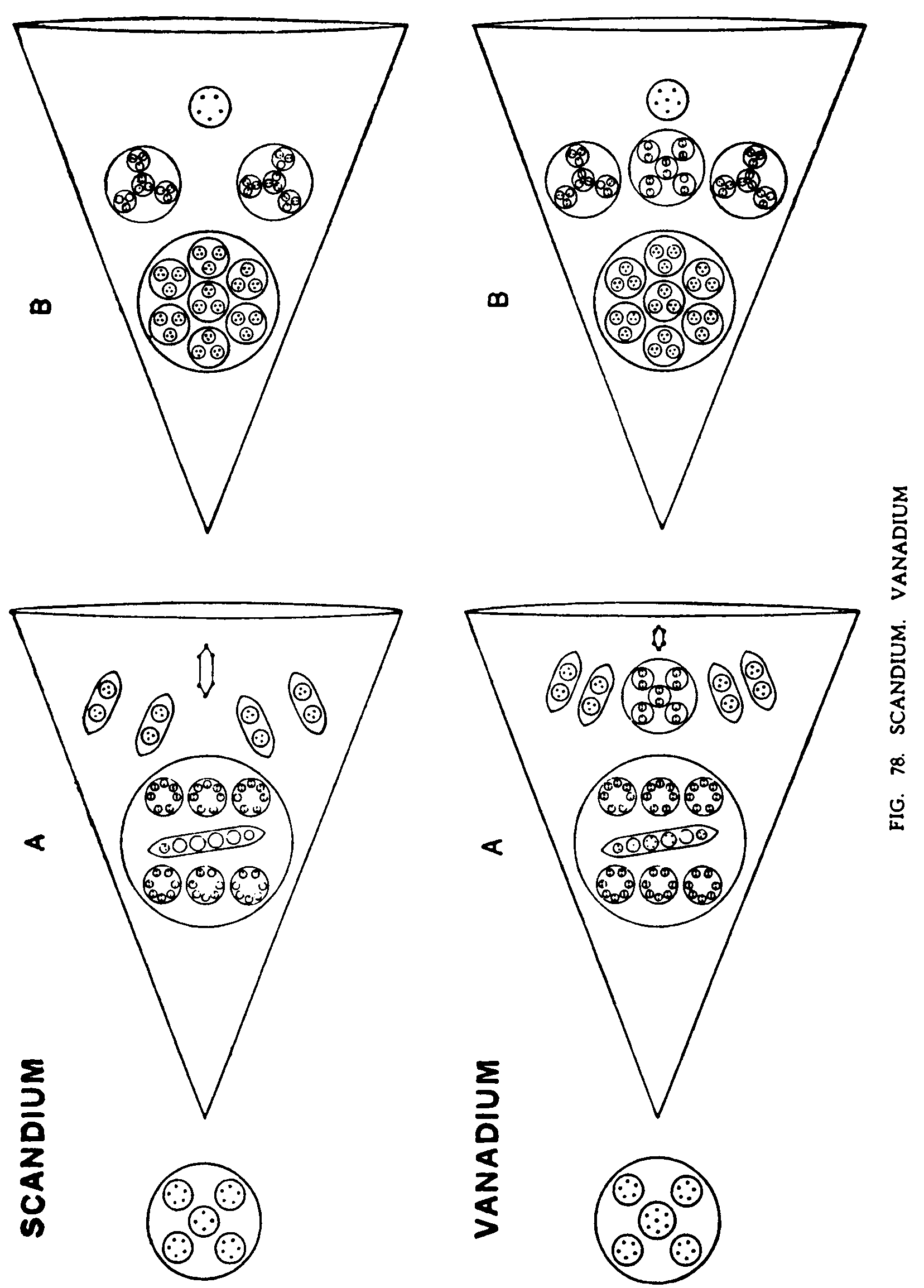
THE CUBE GROUP A 149
ATOMIC
No. 21. SCANDIUM
In
Scandium for the first time we meet funnels of two different types in the
same atom. The three funnels of type A appear to be positive and those
of type B negative, but this must be stated with reserve. Fig. 78.
Central
globe. The central globe repeats that of Boron, with an additional
sphere of four Anu in the centre.
Funnels.
In
the A type the Boron funnel Is
reproduced, the Ad6 having risen above its
companion ovoids ; but the most important matter to note in respect to
this funnel is the introduction of the body N110. This body was observed
by us first in Nitrogen, in 1895, and we gave it the name of the " nitrogen
balloon," for in Nitrogen it takes the balloon form, which it also often
assumes in other gaseous elements. Here it appears as a sphere, the form
it always assumes oĽ the E4 level. It will be observed that this N110 appears
in every member of this group except Boron.
The B type of funnel runs largely to triads. It contains N63, which has not only a triadic arrangement of spheres within its contained globes, but each sphere has also a triplet of Anu. The funnel also contains two N24 and is completed by a sphere of five Anu at the top of the funnel.
Scandium = (4B5+Be4) -f-3 [N110+4 (2H3) -f-Ad6] +3 [N63+2N24+B5]
Central globe -= 24 Anu
3 funnels A of 140 Anu - 420
_
3 funnels B of 116 Anu =. 348
Total == 792 Anu
Number
weight ~ - 44.00
18
ATOMIC
NO. 23. VANADIUM
Vanadium
closely follows Scandium. Fig. 78.
The central globe has seven Anu, 1.7, in its. central body, instead of four as
in
Scandium.
Funnels. The funnels of type A only differ from those of Scandium by having
a
globe, N20, inserted in the ring of four ovoids.
The B type funnels have a globe containing six Anu instead of five at the top,
and
slip in a third globe containing twenty Anu, N20, between the two N24 of
Scandium.
In this way Vanadium succeeds in overtopping Scandium by 126 Anu.
Vanadium
= (I.7+4B5)+3 [N110-bN20-I-4 (2H3)-f-Ad6] +3 [N63+2N24+N20+N6]
Central
globe
-=
27 Anu
3
funnels A of 160 Amu =- 480 _
3
funnels B of 137 Anu = 411 _
Total = 918 Anu
Number weight 18 = 51.40
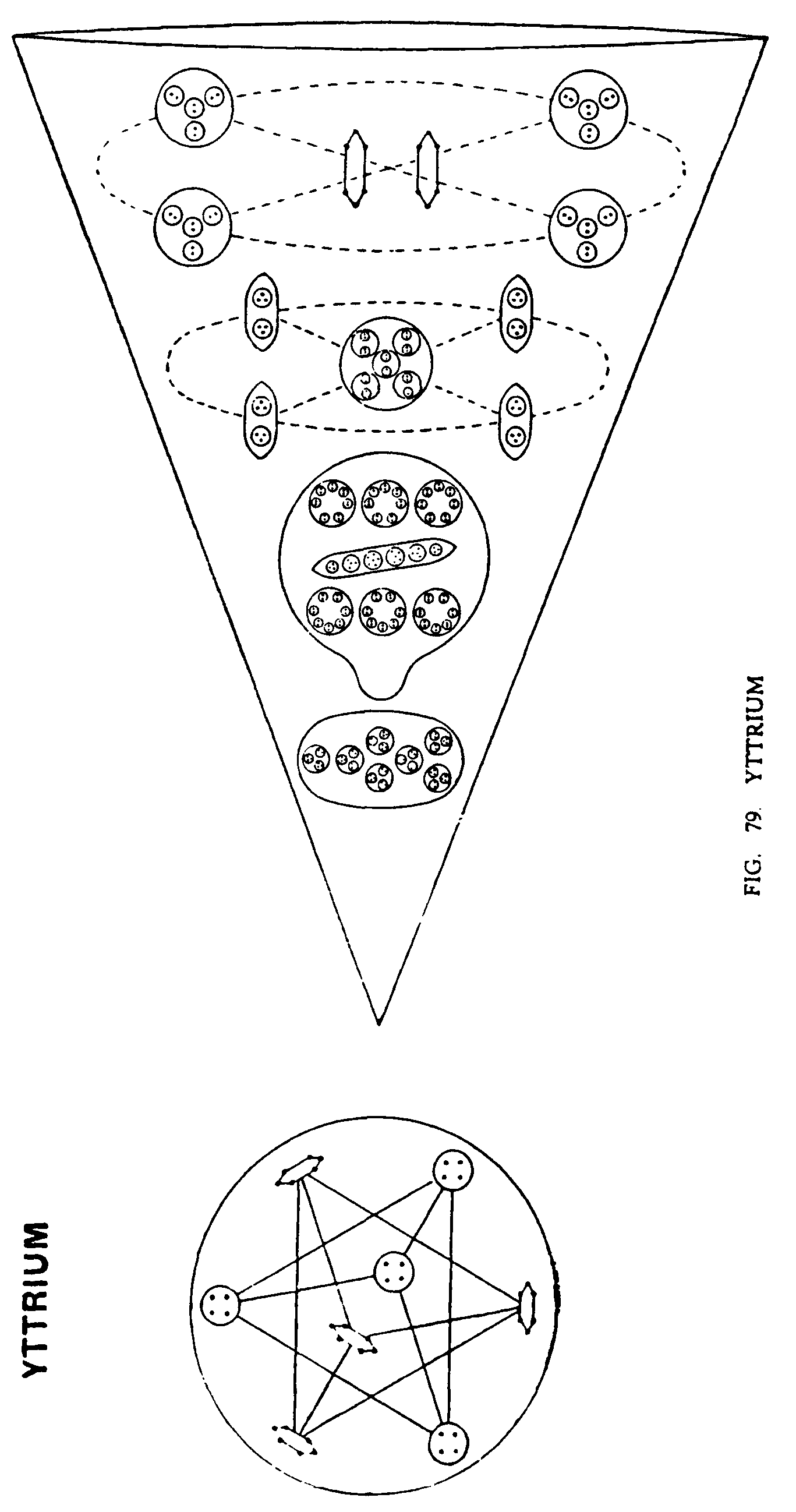
THE CUBE GROUP A 151
ATOMIC
NO. 39. YTTRIUM
The
-central globe presents us with two tetrahedrons, recalling one
of the combinations in Adyarium and in Gold, and differing from that in
Gold only by the substitution of two quartets for the two triplets. Fig.
79.
Funnels.
The
funnels are of one type only, and we have here quite a new arrangement
of bodies within the funnel. At the bottom comes N63, followed by N110.
The N63 is slightly lengthened.
Two
Ad6 whirl on their own axes in the centre near the top, while four globes
of eight Anu chase each other in a circle round them, spinning madly on
their own axes. This axial spinning seems constant in all contained bodies.
Lower down in the funnel a similar arrangement is seen, with a globe, N20,
replacing the two Ad6, and four ovoids of six Anu replacing the globes
of eight Anu. This group is identified as Yb44.
One
funnel of Yttrium contains exactly the same number of Anu as is contained
in a gaseous atom of Nitrogen. Further. N110, N63 and N20 are all constituents
of Nitrogen. We put on record these facts, without trying to draw any conclusions
from them. Some day we, or others, may find out their significance, and
trace through them obscure relationships.
Yttrium - (Ad24+Yt16)+6 [N63-f-N110-+-Yt44+ (4Yt8+2Ad6])
Central globe = 40 Anu
6 funnels of 261 Anu = 1566 11
Total = 1606 Anu
Number weight 1~ = 8922
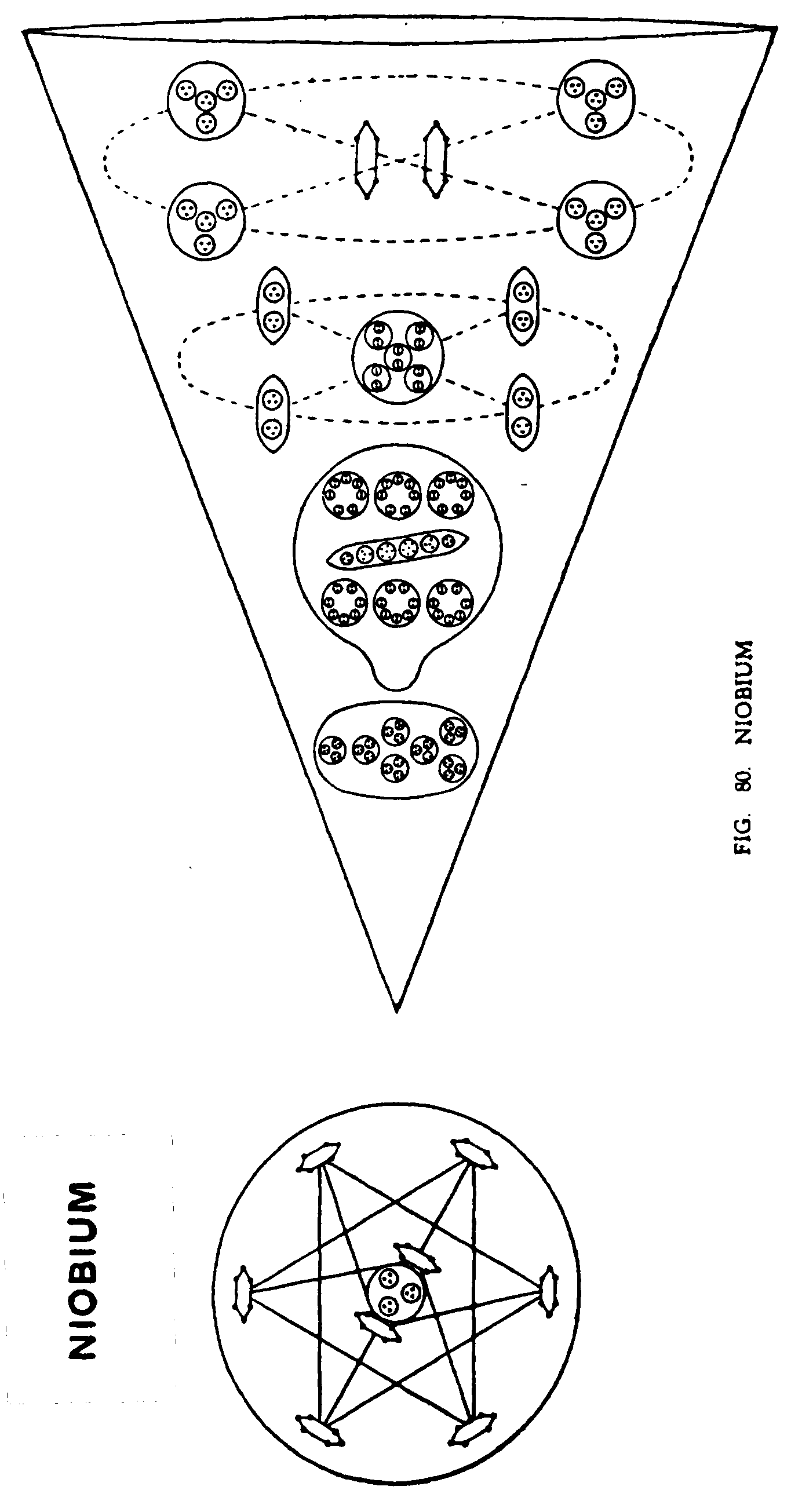
ATOMIC
NO. 41. NIOBIUM
This
element is as closely related to Yttrium as is Vanadium to Scandium. Fig.
80.
Central
globe. In the central globe we find two interlaced tetrahedrons each
of four Ad6, 2Ad24, and a central sphere of nine Anu, N9, spinning round
in the centre. seventeen Anu being thus added in each globe.
Funnels.
Niobium
contains only one type of funnel, and these are exactly like
those of Yttrium, save that the little globes which scamper round the two Ad6 contain twelve Anu instead of eight Thus each funnel contains N63, N110, Yt44 and the new group which is identified as Nb60.
Niobium = (2Ad24+N9) +6 (N63+N110+Yt44+N660)
Central
globe
---
57 Anu
6
funnels of 277 Anu = 1662
Total = 1719 Anu
Number weight ~ = 95.50
ATOMIC
NO 57 LANTHANUM
This
element is closely related to Vanadium and Niobium. It also uses two of
the forms belonging to the Calcium group, which have apparently been brought
over from its predecessor in atomic weight, Barium, by the evolutionary
force. Figs. 81, 82.
Central
globe. The central globe is formed from a very striking group which
occurs very often. It is made of five interpenetrating tetrahedrons, each
tetrahedron being formed of four Ad6, making the group Ad24. The group
of five of these tetrahedrons occurs first in Neon and has been called
Ne120. In Lanthanum there is a small sphere of seven Anu, 1.7, at the centre
of the Ne120.
Funnels.
As
in Vanadium we find here two types of funnels.
Type
A. These three funnels contain six groups, that nearest the centre
being N63. Next we find N110, and then two groups from the Calcium type,
Mo46 and Ca70. Then comes the group Yt44, and finally the large group Nb60.
Type B. These three funnels differ from those of the A type only in having a group Ca45 instead of the Mo46.
Lanthanum
= (Ne120+I.7)+3 [N63+N110+Mo46+Ca70+Yt44+Nb60]
+3
[N63+N110+Ca45+Ca70+Yt44+Nb60]
Central
globe = 127 Anu
3
funnels A of 393 Anu = 1179 _
3
funnels B of 392 _ = 1176 _
Total
= 2482 Anu
Number
weight ~ = 13y.9
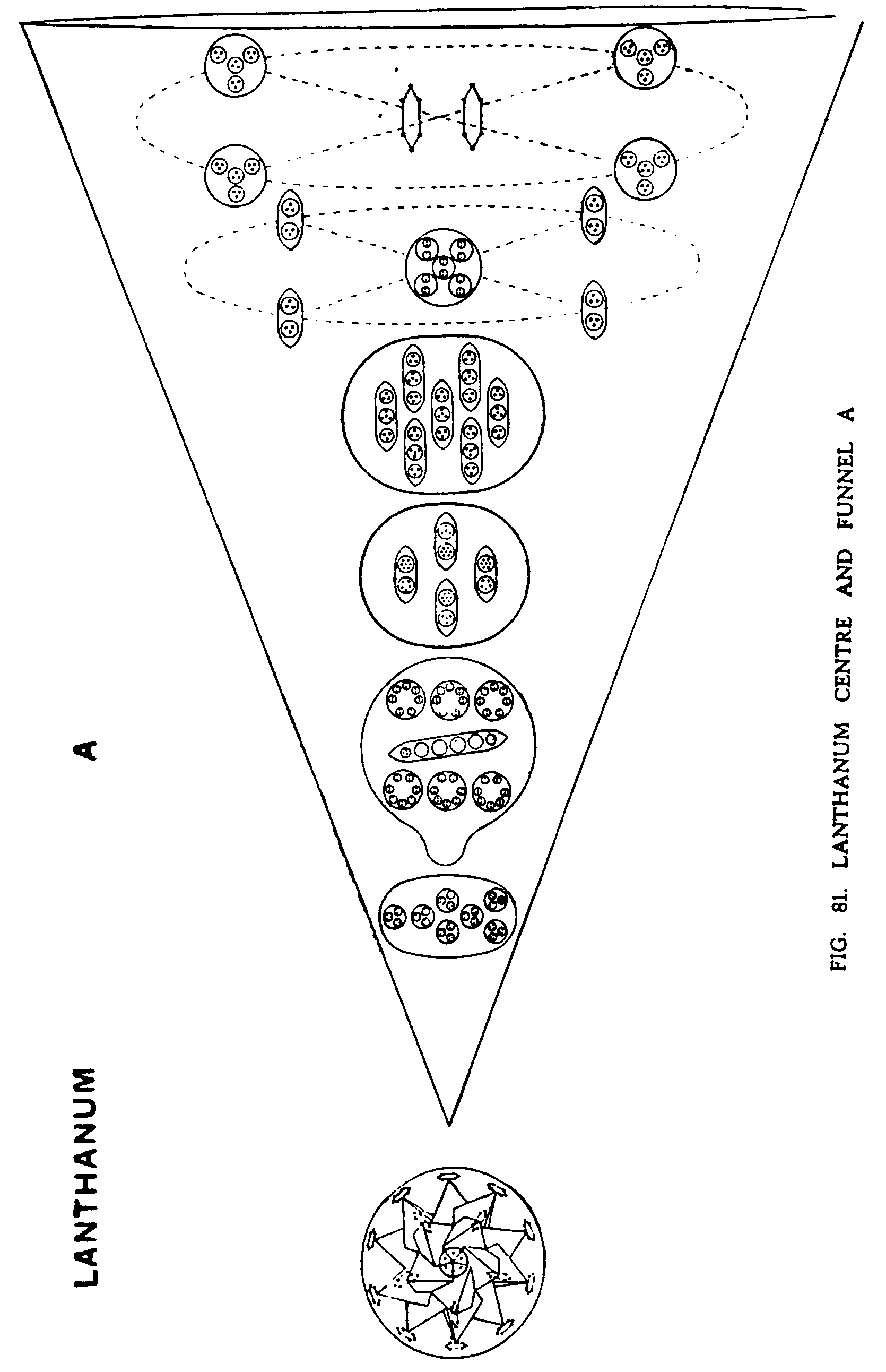
THE CUBE GROUP A 155
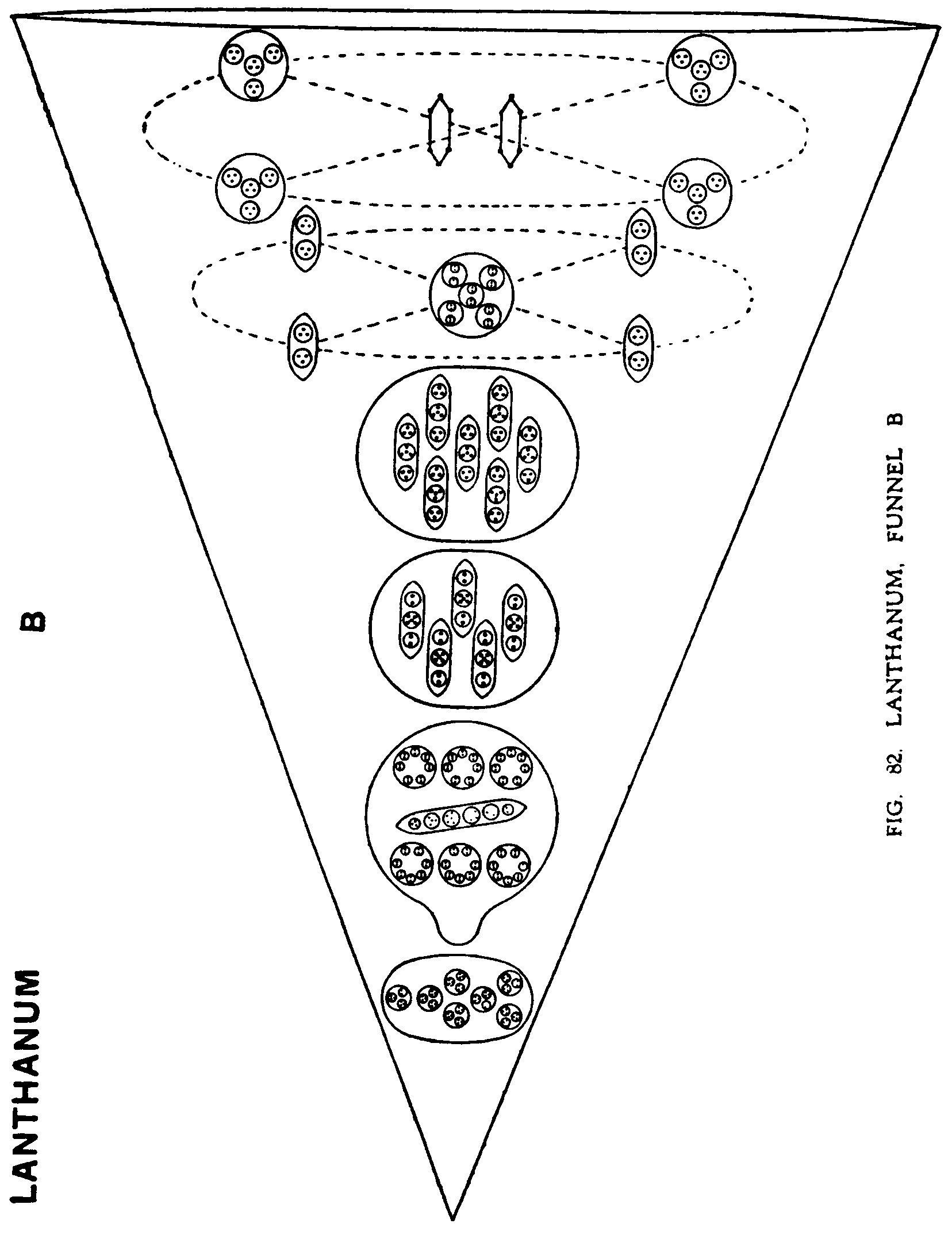
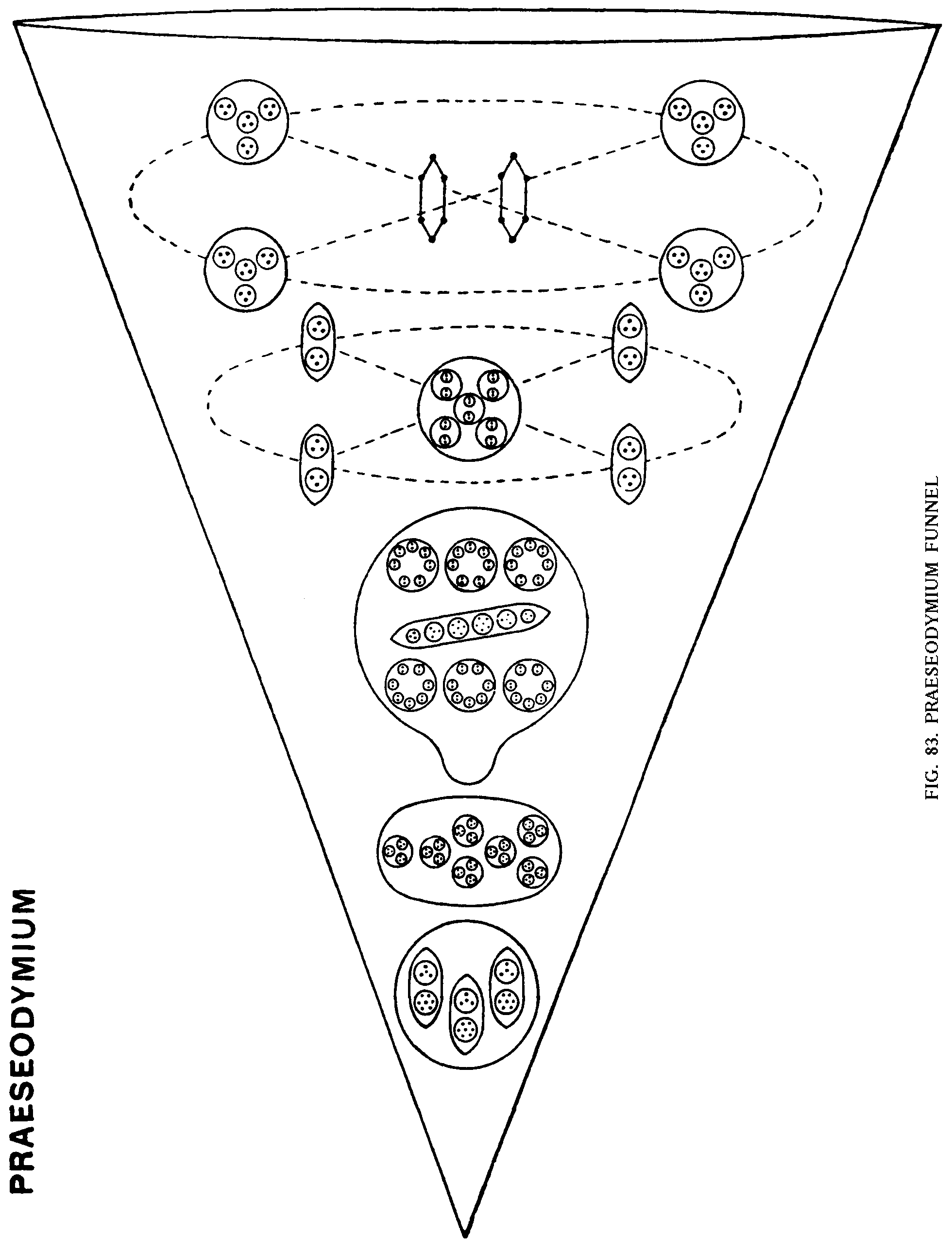
THE CURE GROUP A 157
ATOMIC
No. 59. PRAESEODYMIUM
Central
globe.
The Central globe, Fig. 84, is complex and is borrowed from Cerium, its
predecessor in the atomic weight list. It consists of a centre-piece of
27 Anu. Ce27, and then a ring of twenty segments, each containing 32 Anu.
Thus the central globe is identical with Ce667. It also occurs in Neodymium.
Funnels. Praeseodymium has six similar funnels. Fig. 83. At the bottom of the funnel comes a group containing three ovoids, Moll, making Pr33, and then the N63 and N110 groups. Next comes the Yt44, and finally Nb60.
Praeseodymium = Ce667+6[Pr33+N63+N110+Yt44+Nb60]
Central
globe = 667 Anu
Six
funnels of 310 Anu =1860
Total = 2527 Anu
Number weight ~ = 140.4
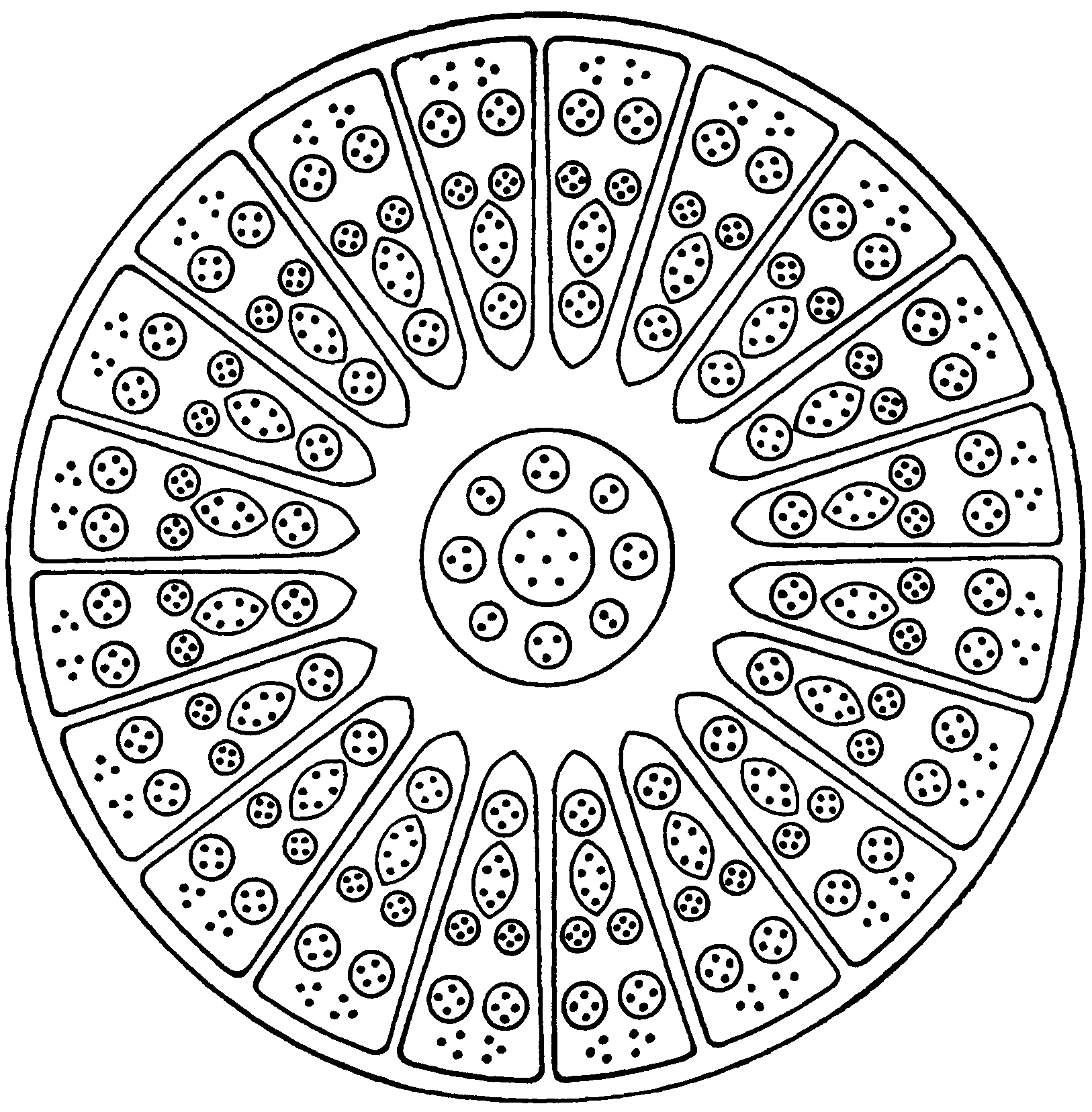
THE
CUBE GROUP A 159
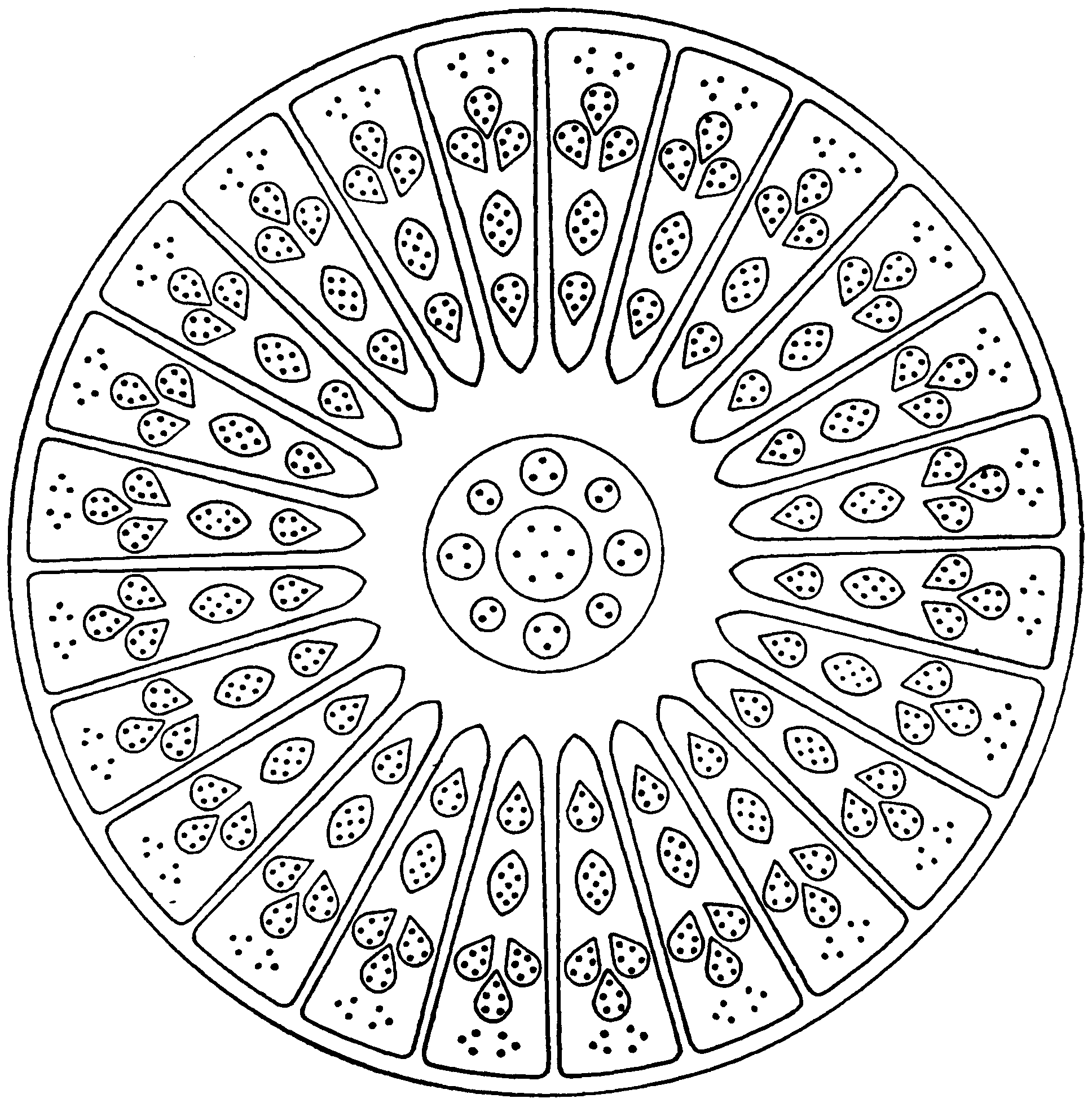
FIG.
85. LUTECIUM CENTRE, Lu819
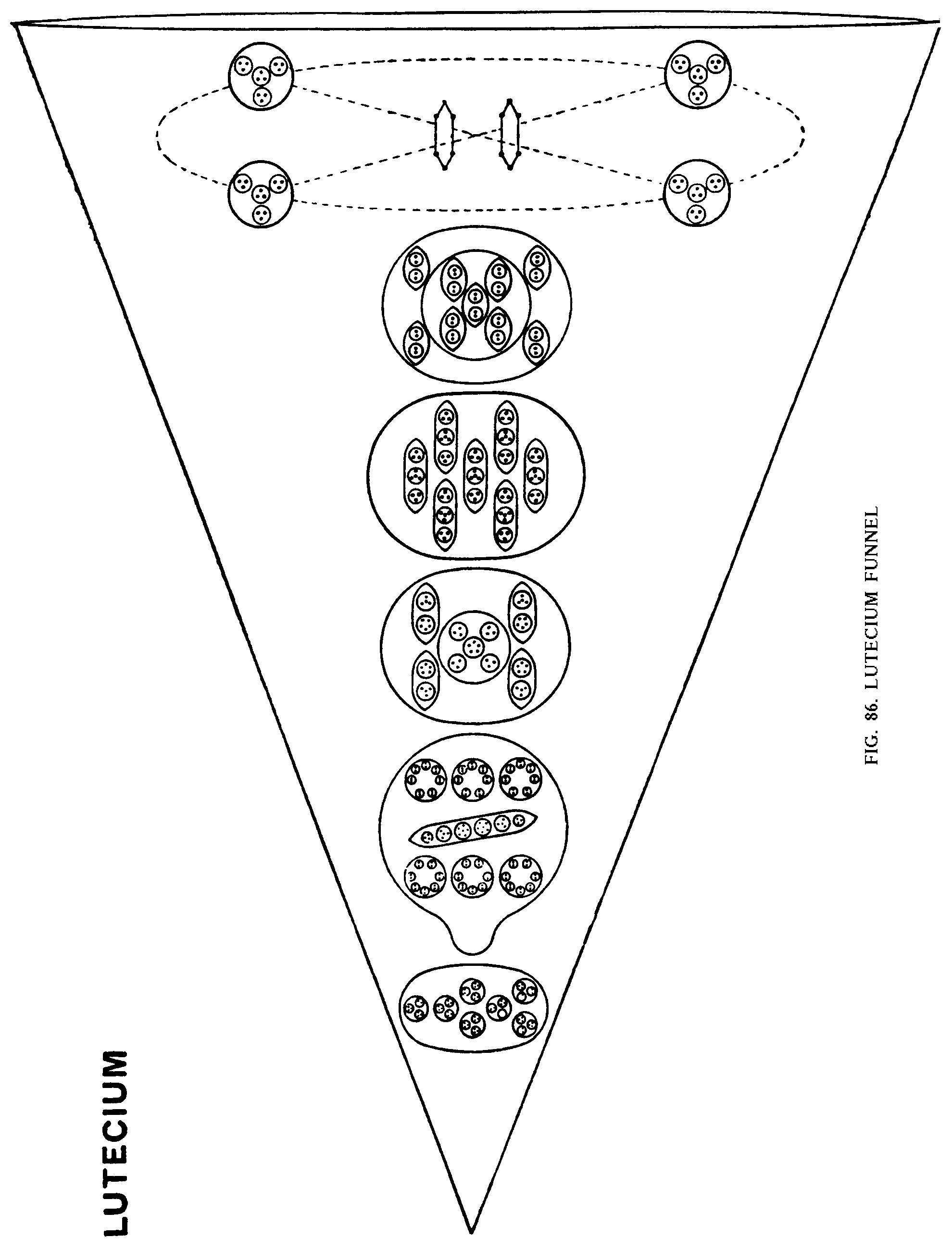
THE CUBE GROUP A 161
ATOMIC
NO. n. LUTECIUM
Central
globe. In this element occurs the remarkable central globe containing
819 Anu which is found in Radium and other elements. As Lutetium is the
element of lowest atomic weight in which this globe occurs it has been
identified as Lu819. The globe is formed of a grand centre of 27 Anu surrounded
by 24 segments of the Ba33 form, making up the 819 Anu. Fig. 85.
Funnels. Lutetium has six similar funnels. At the bottom of the funnel we find first N63, then N110, and then a group Lu53. Neat comes Ca70 and then another new group Lu36 instead of the usual Yt44, and finally the familiar Nb60. Fig. 86.
Lutetium
= Lu819+6 [N63+N110+Lu53+Ca70+Lu36+Nb60]
Central
globe . = 819 Anu
6
funnels of 392 Anu = 2352 _
Total
=
3171 Anu
Number weight 31$1 = 176.17
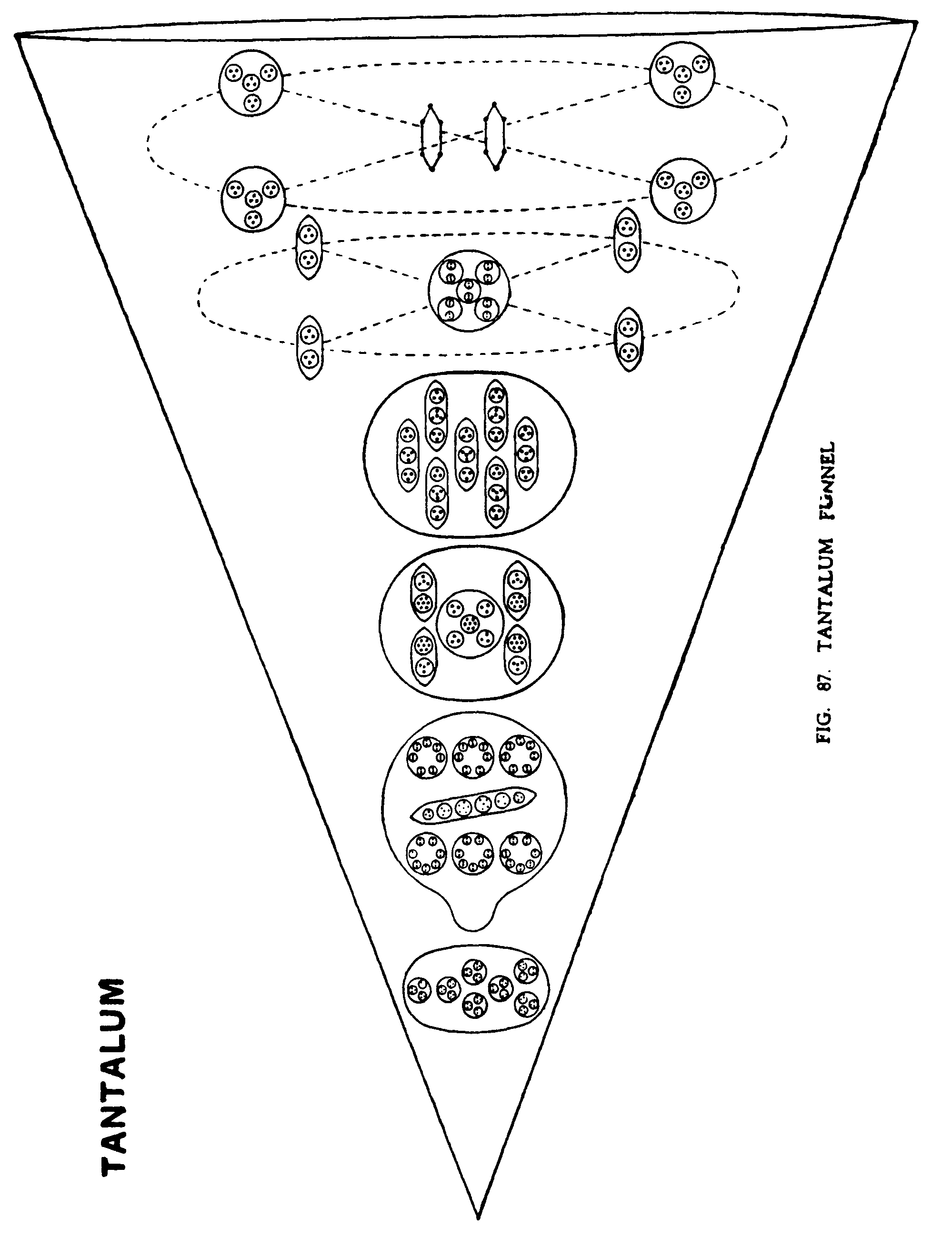
THE
CUBE GROUP A 163
ATOMIC
NO 73 TANTALUM
Central
globe. The central globe is identical with that of Lutecium. Lu819.
Fig. 88.
Funnels. Again we find six similar funnels opening on the faces of a cube. Fig. 87. At the bottom of the funnel we find first the N63 group, then N110. Next comes a group peculiar to Tantalum, Ta63 ; after that we find one of the all pervading Calcium type, Ca70, and then Yt44, and finally Nb60.
Tantalum =Lu819+6 [N63+N110+Ta63+Ca70+Yt44+Nb60]
Central
globe =-- 819 Anu
6
funnels of 410 Anu -- 2460
Total ---- 3279 Anu
Number weight 3i$ = 192.1
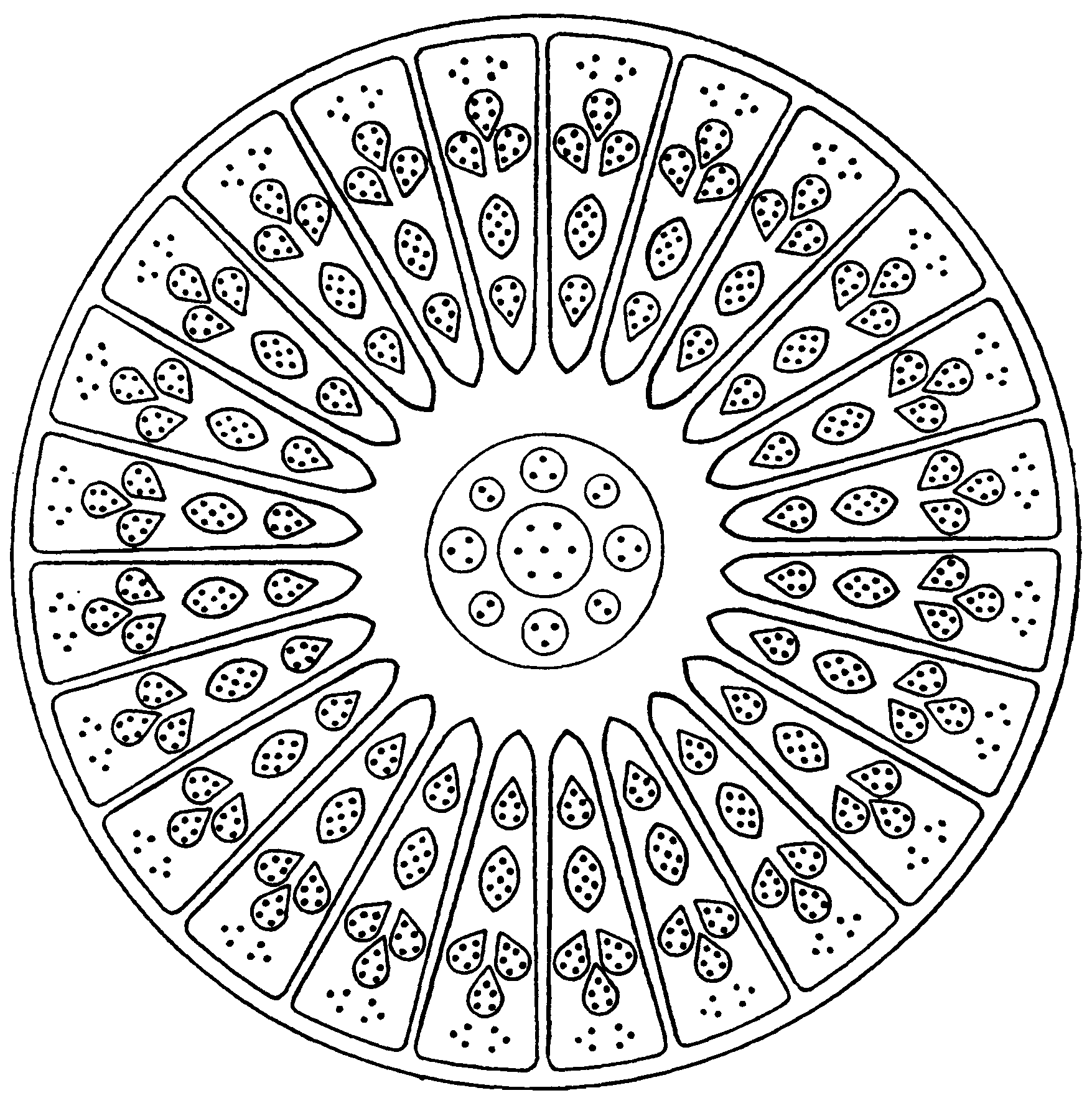
THE CUBE GROUP A 165
ATOMIC
NO. 89. ACTINIUM
This
element shows relations with more than one of the preceding elements both
of its own and other groups. It has two types of funnels, and adds eight
spikes, directed to the corners of the cube.
Actinium
is a true element and not the temporary product of a heavier element. It
is itself radioactive.
Central
globe.
The globe is identical with that of Tantalum, Lu819. Fig. 88.
Funnels
Tvpe
A. These funnels are very similar to those of Lanthanum. They contain the
whole of the Lanthanum A type funnel, with the addition of two Ca45 groups.
Fig. 89.
Type B. For these three funnels Actinium has borrowed from Antimony and Zirconium. They contain the large ovoid from the arm of Zirconium, Zr212, which we shall describe later when we come to discuss that element. In addition to the Zr212, the funnel contains two groups from Antimony, Sb128. and Sb113 plus three extra Anu making up Ac116. Fig. 90.
Spikes. There are eight spikes. each consisting of Li63.
Actinium == Lu819+3 (N63+N110-I-Mo46+Ca160-f-Yt44+Nb60) +3[Zr212+Sb128+Ac116] +8Li63
Central
globe = 819 Anu
3
funnels A of 483 Anu = 1449
3
funnels B of 456 Anu = 1368
8
spikes of 63 Anu = 504
Total = 4140 Anu
Number weight 4140 = 230.0
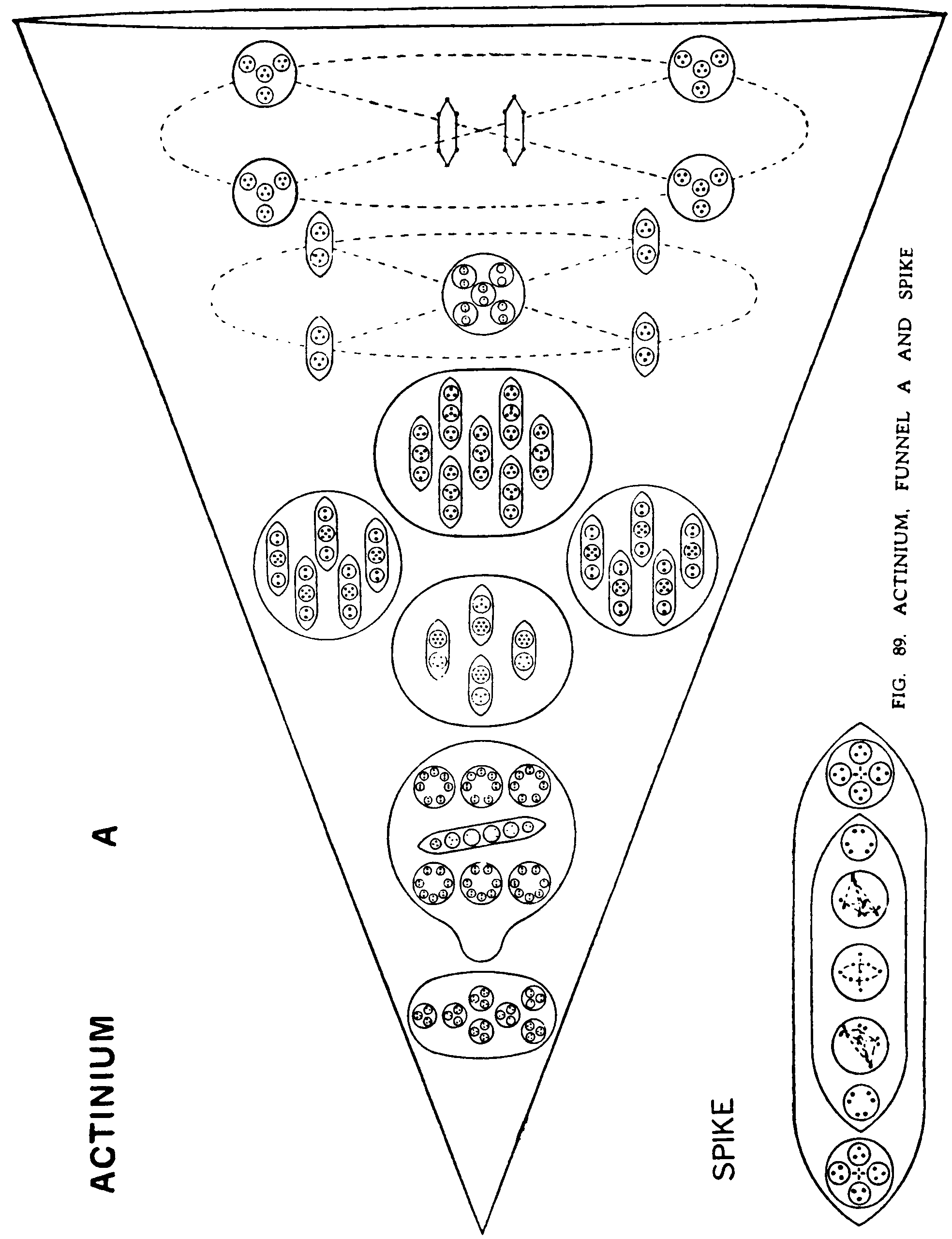
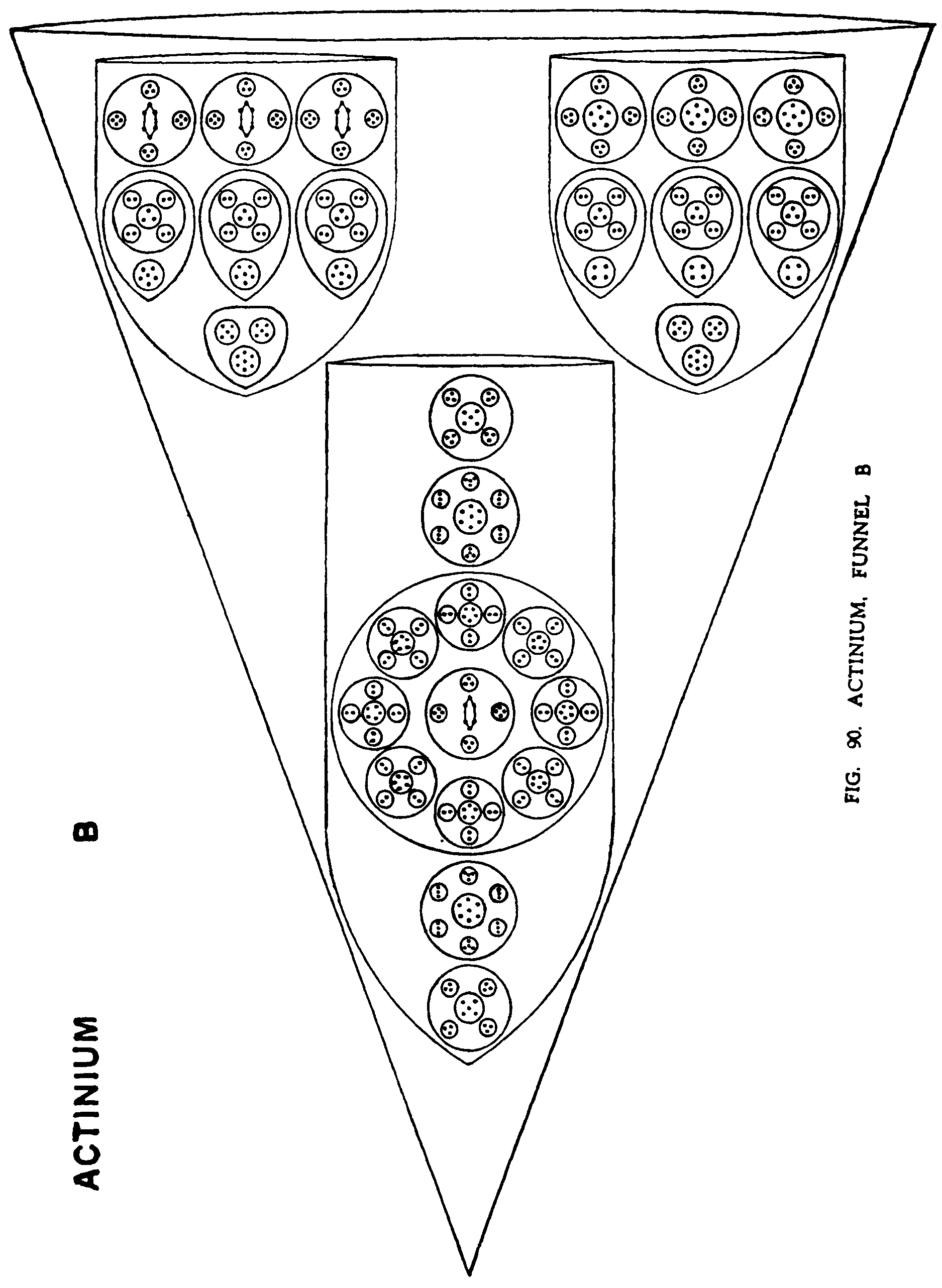
168
OCCULT CHEMISTRY
ATO HC No. 91. PROTO-ACTINIUM
This element is very similar to Actinium. It contains two types of funnels and eight spikes.
Type
A. These three funnels are exactly like the A type funnels in Actinium
and contain 483 Anu. Fig. 92.
Type
B. These three funnels contain the whole of the Actinium B funnels,
Ac456, with the addition of a new group Pa29. Pa29 contains four Ad6 and
a B5, the Ad6 being in a ring as shown. Fig. 93.
THE
CUBE GROUP A 169
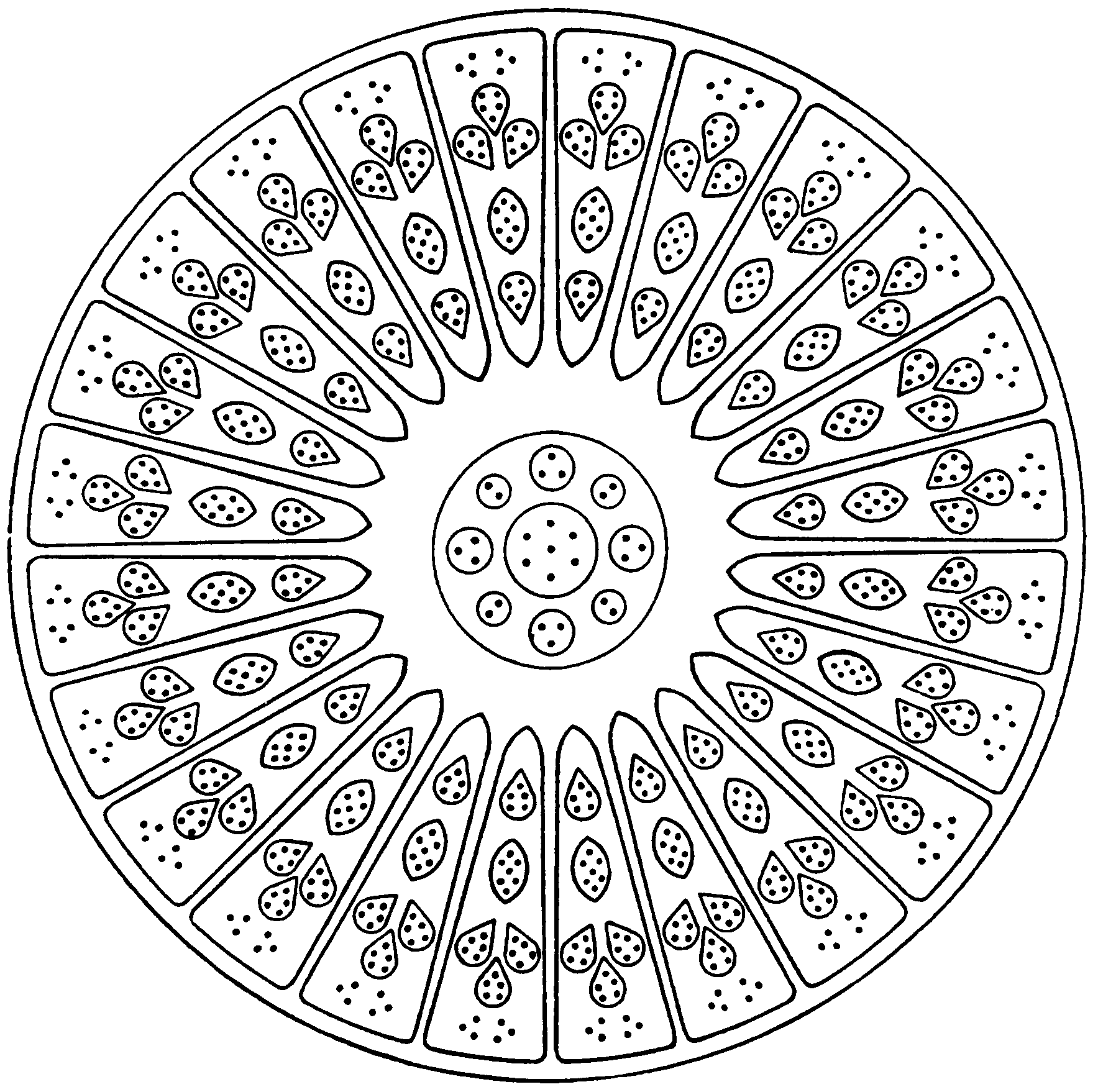
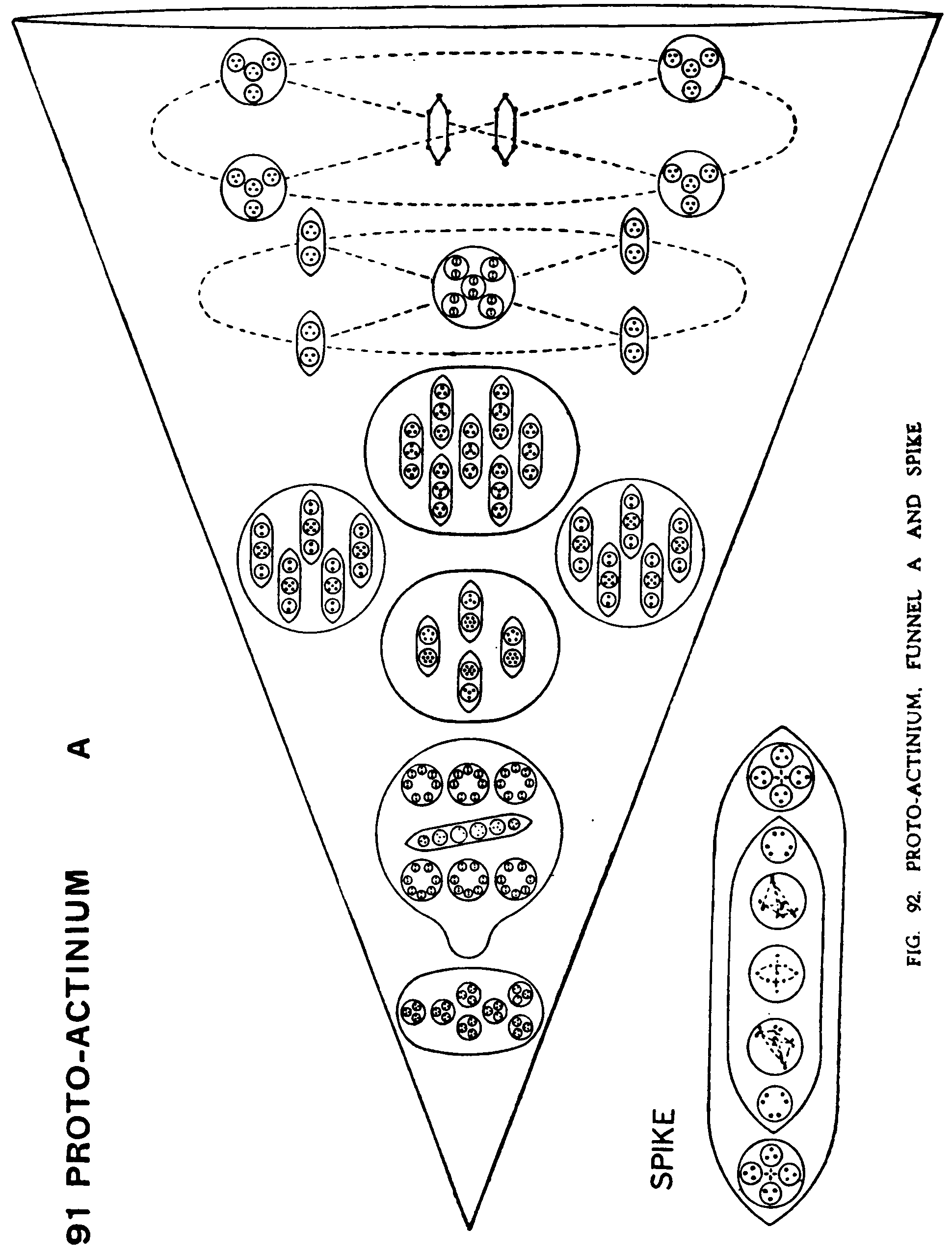
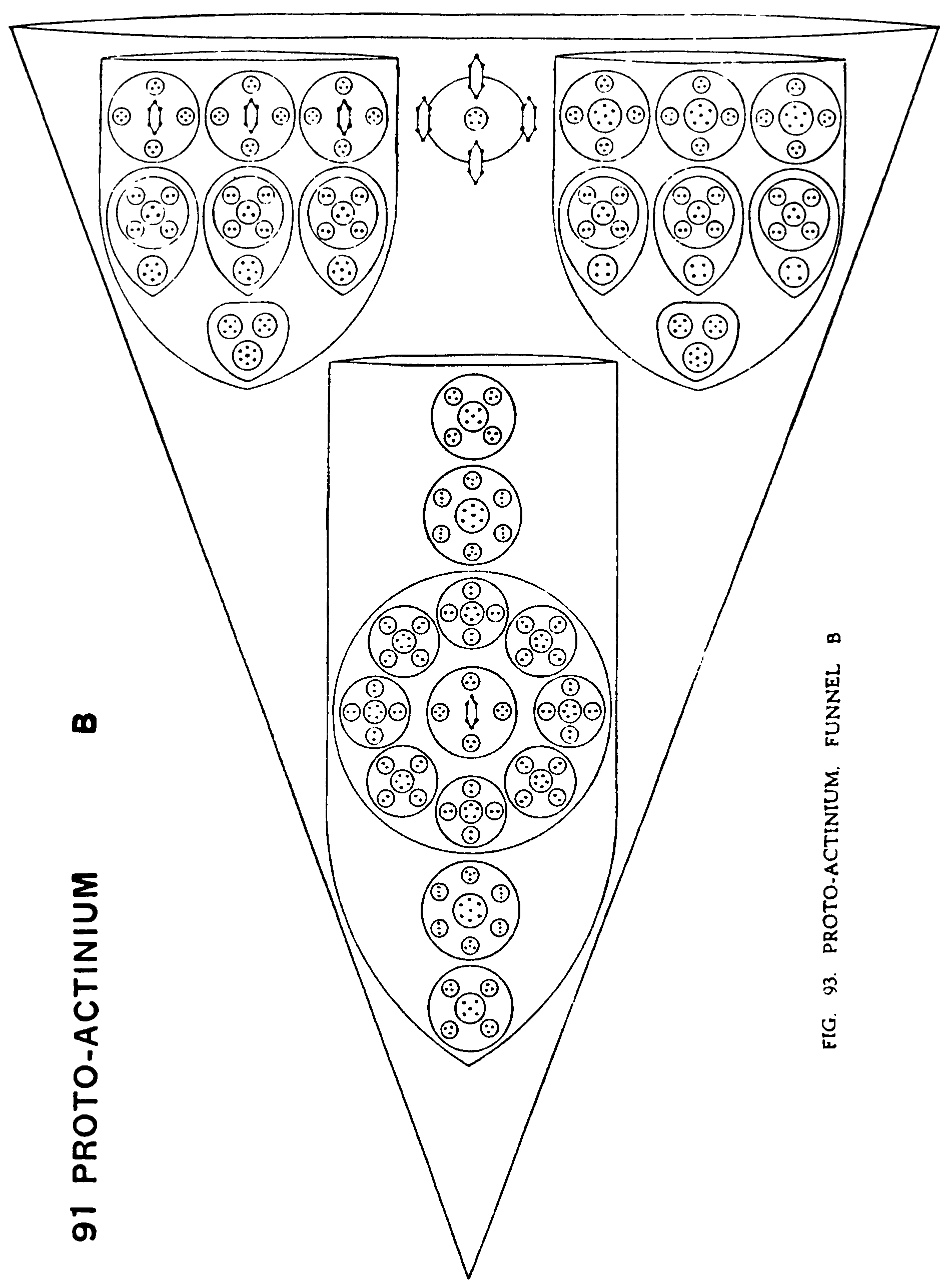
172
OCCULT CHEMISTRY
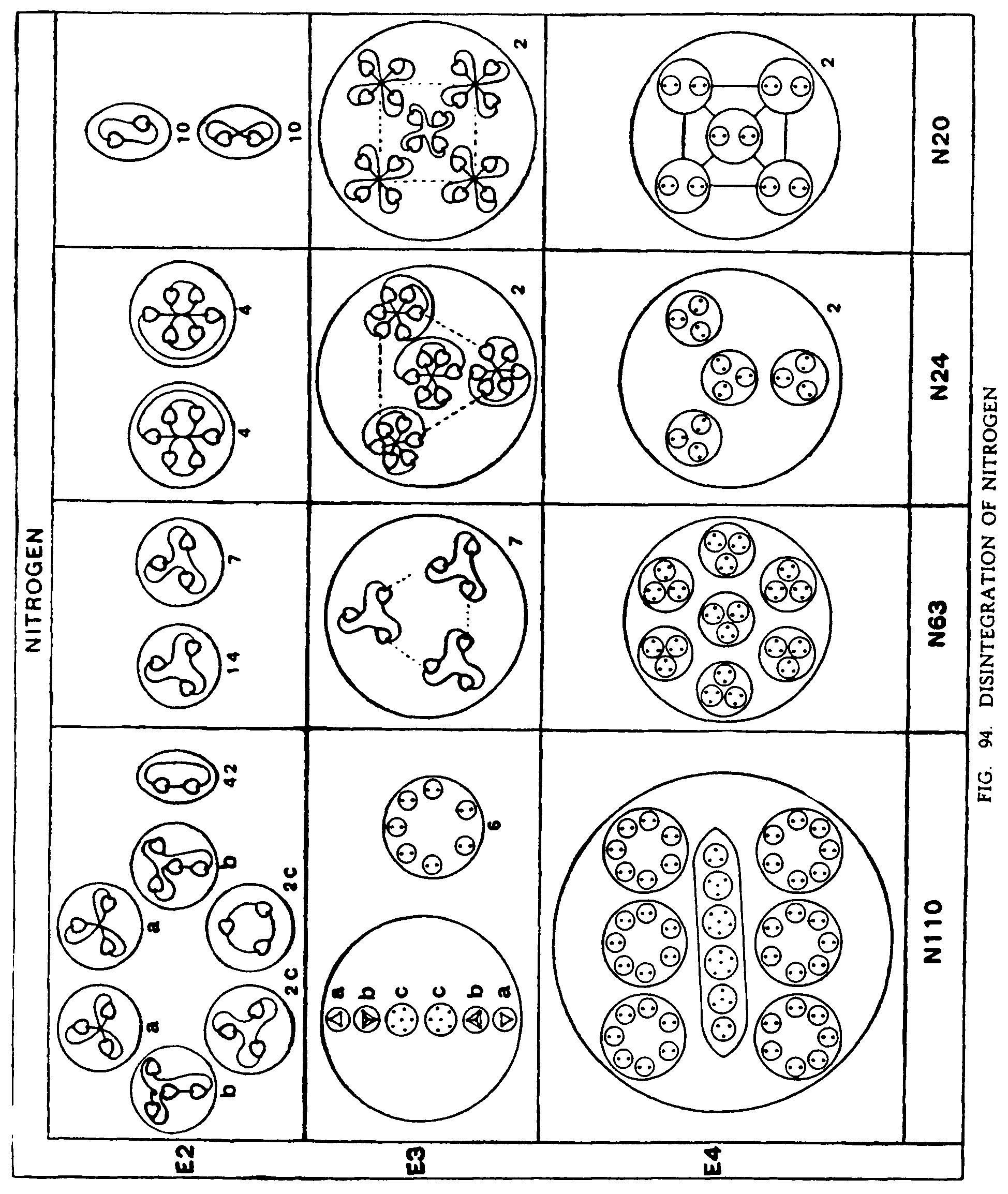
N110. The " balloon," N110, changes to a sphere, and holds together nn the E4 level ; on the E3 it yields six globes each containing seven duads, and these are all set free as duads on the E2 level. The ovoid is also set free on the E3 level, becoming a sphere; and on the E2 level it liberates its contained bodies, as two triplets, two quartets and two sextets which immediately become triplets.
N63. This body is liberated on the E4 level. On the E3 level it sets free seven bodies of 9 Anu and these become twenty-one triplets on the E2 level.
N24. The two N24 spheres are liberated on the E4 level. On the E3 level each assumes a tetrahedral form with six Anu at each point. On the E2 level each gives four sestets.
N20. On the E4 level each N20 is found as a tetrahedral arrangement of pairs of duads at the angles of a square-based pyramid.
On the E3 we find a similar arrangement though the distribution of the forces is changed. On the E2 level the groups separate into 10 duads from each N20.
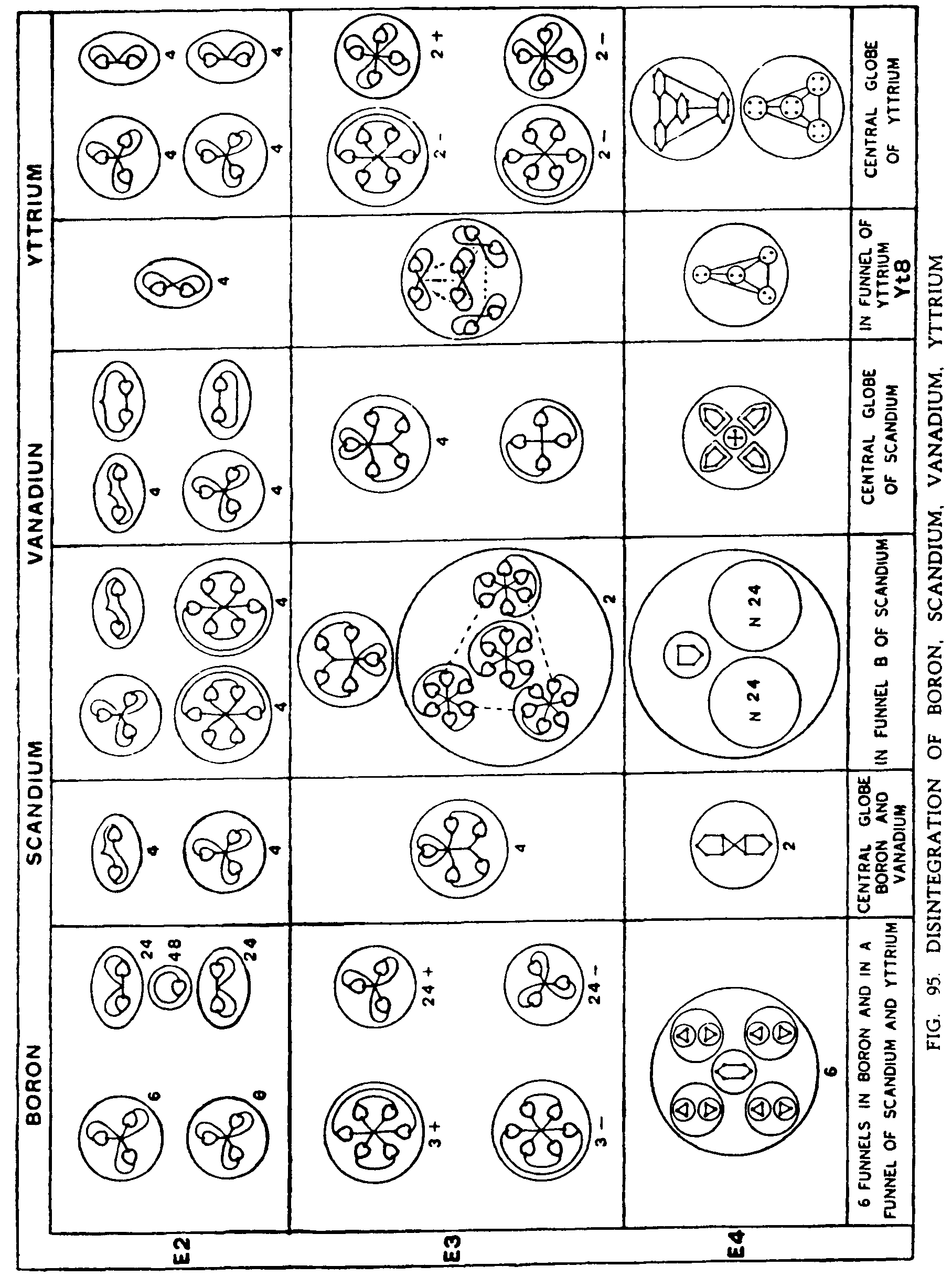
The Central globe, with its four quintets, is set free and breaks at once into two groups of ten Anu. Fig. 95.
On the E3 level four quintets are formed which, on the E2 level, are resolved into triplets and duads.
The funnels. The six funnels are first set free on the E4 level, where they assume the spherical form, showing a central Ad6 and four globes each containing two triplets.
On
the E3 level the Ad6 behaves as usual and the triplets separate. On the
E2 level the Ad6 gives triplets and the other triplets give duads and units.
The Central globe shows a cross at its centre, with the four quintets whirling round it, on the E4 level. On the E3 level the quintets are set free and follow the Boron type, while the cross becomes a quartet. On the E2 level each quintet gives a triplet and a duad and the quartet two duads. Fig. 95.
Funnels A. In funnels A the Ad6 and the ovoids behave as in Boron, but the N110 escapes from the funnel as it changes to a sphere and holds together on the E4 level. The N110 disintegrates as shown under Nitrogen and the rest of the funnel as in Boron.
Funnels
B. The N63 escapes when the funnel becomes a sphere on the E4 level.
The remaining sphere contains the two N24 and the quintet B5. On the E3
and E2 levels these groups behave as in Nitrogen and Boron.
The Central globe follows the pattern of the globe of Boron. Fig. 95. The centre sphere 1.7 is shown in Iodine.
The A funnels of Vanadium repeat the A funnels of Scandium with the addition of N20. All these disintegrate as shown under Nitrogen or Boron.
The
B funnels also repeat the B funnels of Scandium with the addition of
a N20 group and the substitution of a sextet, N6, for a quintet. These
also disintegrate as shown under previous elements.
The Central globe breaks up into two groups which disintegrate as shown in Fig. 95.
Funnels. On the E4 level the six funnels are first liberated and then the N110 and N63 escape and behave as shown in Nitrogen. The ovoids. 2H3, and the cigars. Ad6, are set free on the E3 level and behave as in Boron Fig. 95.
Yt8
is a tetrahedral arrangement of duads on the E3 level and these are set
free as duads on the E2 level The N20 behaves as shown under Nitrogen.
176
OCCULT CHEMISTRY
Fig. 96 shows the Cube Group A in a condensed form, from which the relationships in the group may be studied.
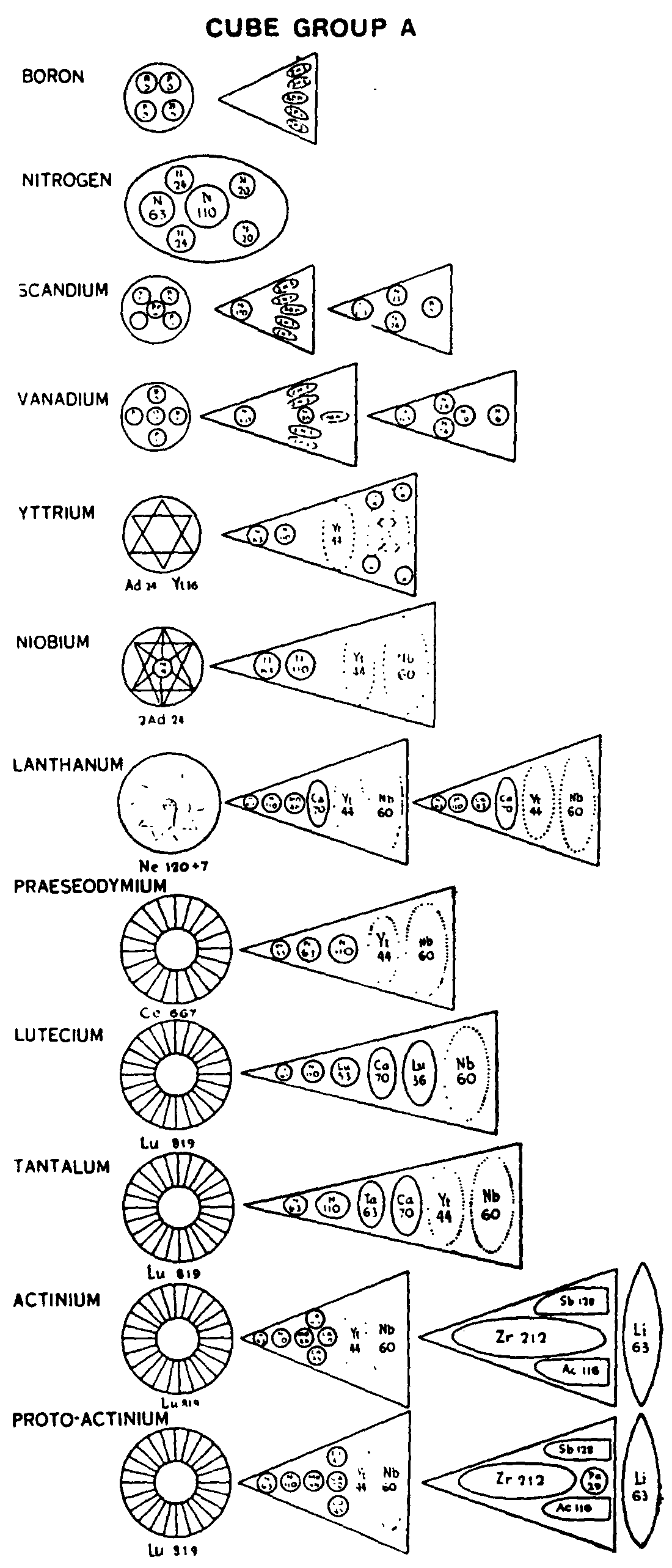
FIG.
96. CUBE GROUP A